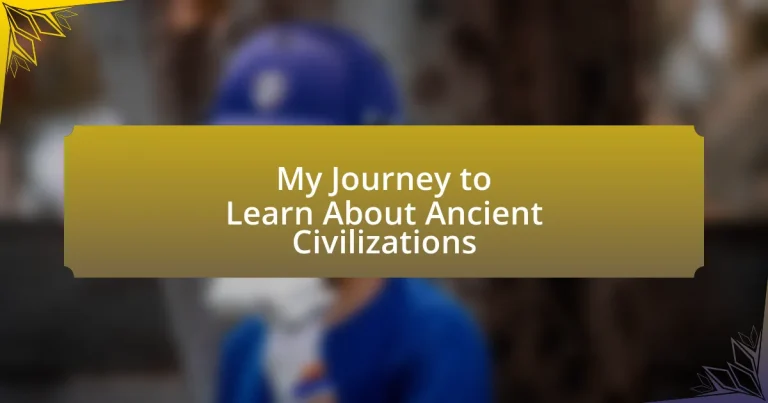Key takeaways:
- Exploring ancient civilizations offers insights into human achievements, struggles, and their impact on modern society.
- Key motivations for studying history include connecting with humanity, learning lessons from the past, and the excitement of discovery.
- Utilizing primary and secondary sources, along with engaging methods like historical fiction and multimedia, enhances the learning experience.
- Understanding history’s relevance today helps connect ancient practices and values with contemporary societal issues and personal perspectives.
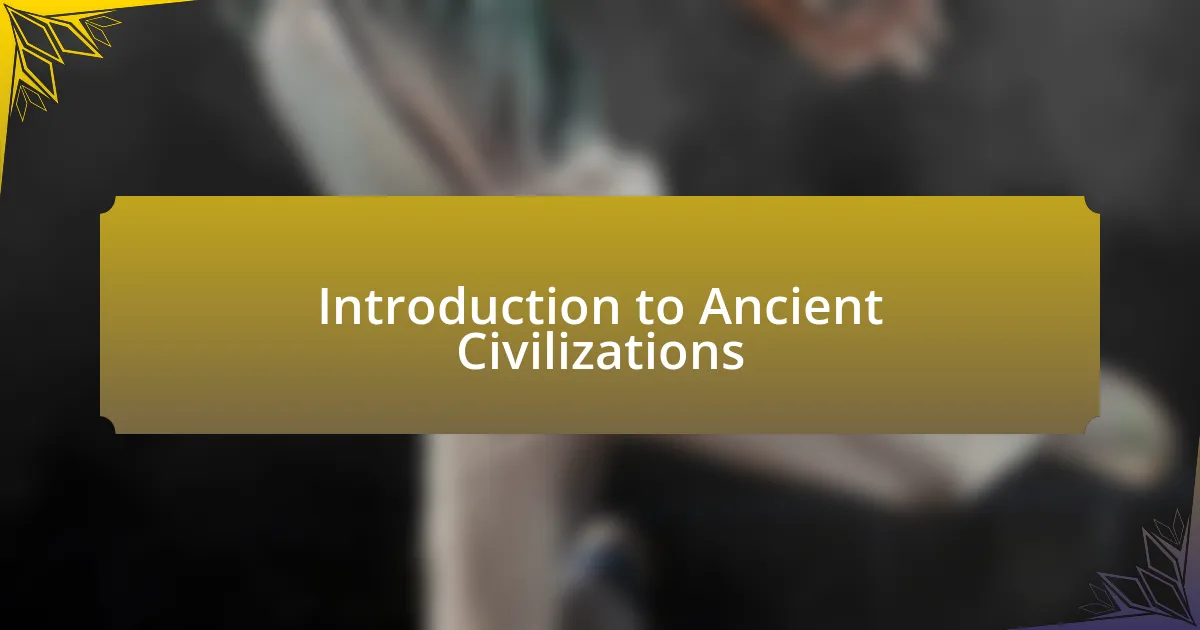
Introduction to Ancient Civilizations
Diving into ancient civilizations fascinates me. I remember the first time I stumbled upon the intricacies of Mesopotamia—the cradle of civilization. How incredible is it to think that this region birthed writing, mathematics, and urban life?
Each civilization, from the Egyptians with their towering pyramids to the Greeks with their philosophical pursuits, tells a unique story of human achievement. I often wonder how these cultures shaped our modern world. Can you imagine walking through the bustling markets of ancient Rome or standing before the majestic Sphinx?
Exploring the legacies of these societies reveals not just their accomplishments but also their struggles, triumphs, and the lessons they leave for us today. It’s like peering into a time capsule that connects us to our shared human experience.
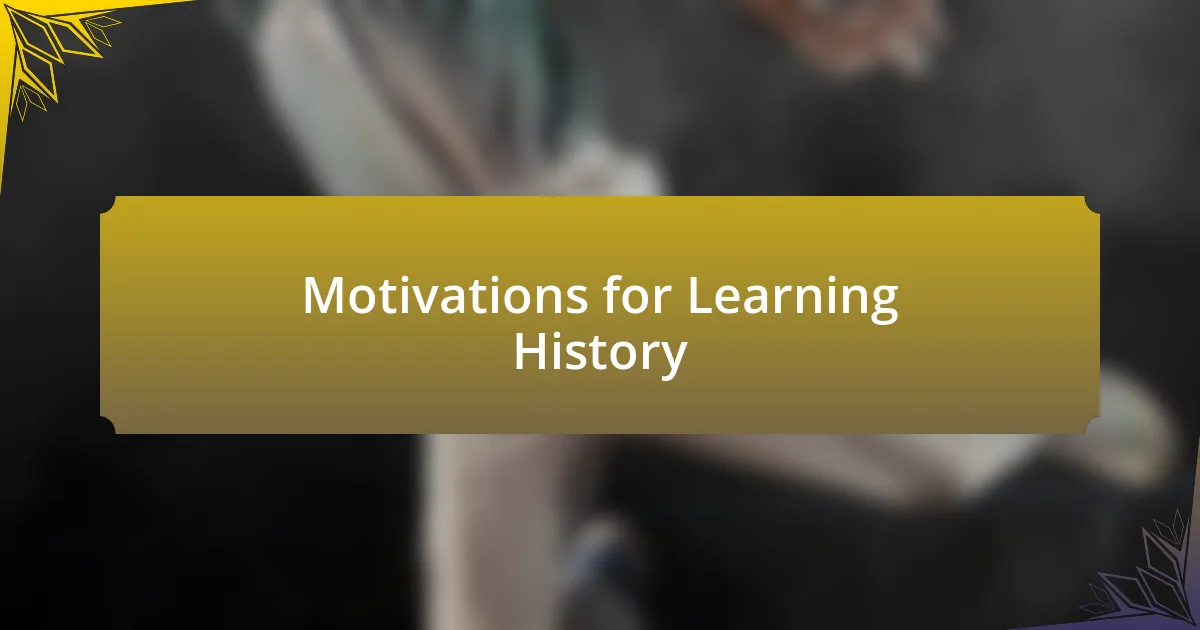
Motivations for Learning History
Understanding history, particularly ancient civilizations, serves numerous motivations that deeply resonate with me. For instance, I often find myself captivated by the idea of connecting with our shared humanity. When I engage with stories from the past, I feel as though I’m not just studying dry facts; I’m actively participating in a conversation that spans centuries. This connection drives my desire to learn more about how ancient peoples lived, thought, and interacted with their environments.
Another significant motivation for exploring history arises from the lessons it imparts. I vividly recall a moment during my studies when I learned about the fall of the Roman Empire. It struck me profoundly—how decisions made long ago still echo in our modern political landscape. This realization fuels my passion for uncovering the moral and ethical dilemmas faced by previous societies, hoping to apply those insights to contemporary issues. Isn’t it fascinating how the past can provide a roadmap for our future?
Lastly, the excitement of discovery is still fresh in my mind. One time, while researching the art of the Ancient Greeks, I uncovered a lost technique that transformed the way statues were created. The thrill I felt in that moment reminded me of how learning history is akin to piecing together a grand puzzle, where each new piece enhances our understanding of the world.
| Motivation | Description |
|---|---|
| Connection to Humanity | Engaging with stories from the past fosters a sense of belonging to our shared human experience. |
| Lessons from the Past | Exploring historical events reveals insights that can inform our contemporary decisions and moral frameworks. |
| Excitement of Discovery | Unearthing new information about ancient practices offers a thrilling sense of adventure in learning. |
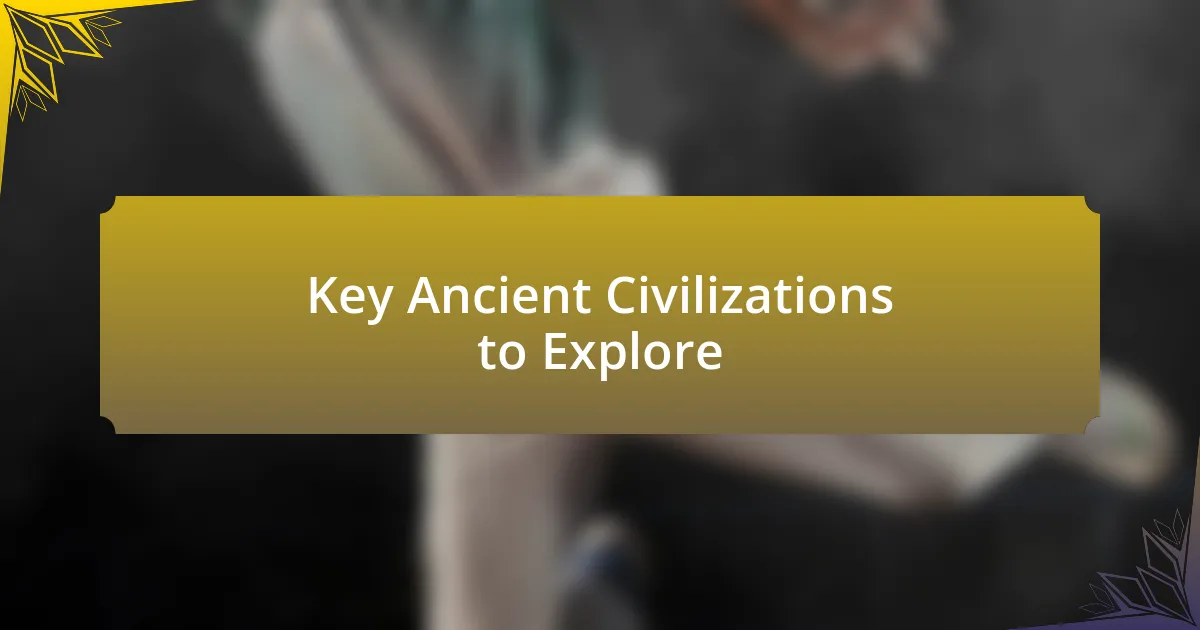
Key Ancient Civilizations to Explore
There are several ancient civilizations that truly capture my imagination. Each one holds its own nuances and stories, inviting exploration. When I think back to my early studies, the majesty of ancient Egypt stood out vividly. I remember the first time I gazed at a photograph of the Great Pyramid of Giza; its sheer scale left me in awe, sparking my interest in the engineering feats of the time. These civilizations not only shaped their world but also laid the foundations for ours.
Here are a few key civilizations worth exploring:
- Ancient Egypt: Known for its monumental architecture and rich mythology, including pharaohs and the afterlife beliefs that continue to intrigue us today.
- Mesopotamia: Often hailed as the cradle of civilization, this area introduced us to writing, laws, and urban life.
- Indus Valley Civilization: This mysterious civilization is celebrated for its advanced urban planning and undeciphered script, provoking countless debates among historians.
- Ancient Greece: Renowned for its contributions to philosophy, democracy, and the arts, its legacy continues to influence modern thought.
- The Roman Empire: A vast empire that made significant advancements in law, engineering, and governance, forever altering the course of history.
Reflecting on these civilizations, I can’t help but recall a research project I undertook on the Indus Valley. I was fascinated to learn about the sophisticated drainage systems that showcased their engineering prowess. It was a reminder that so much of our modern infrastructure owes a debt to these ancient innovators. Each civilization offers a window into how humanity has adapted and evolved, and I find that exploration both thrilling and deeply enriching.
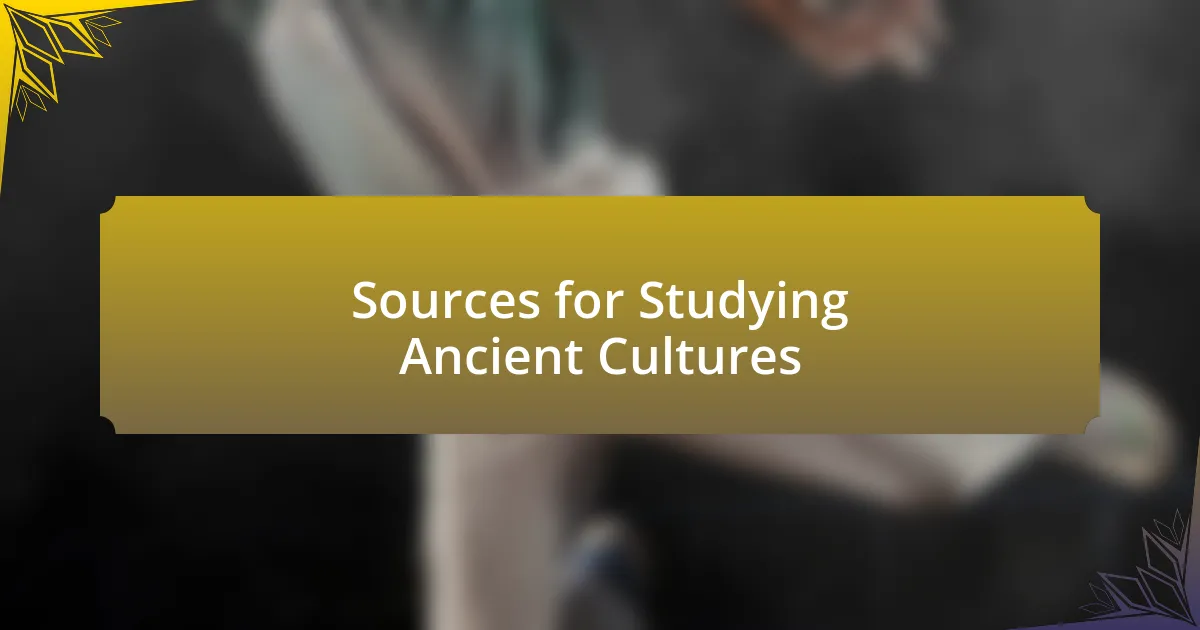
Sources for Studying Ancient Cultures
When delving into the study of ancient cultures, I often turn to both primary and secondary sources. Primary sources, like artifacts and inscriptions, offer a direct glimpse into daily life, customs, and beliefs of ancient peoples. I remember the excitement of examining clay tablets from Mesopotamia during a university seminar; the inscriptions felt like a tangible connection to the past that truly ignited my passion for history.
Secondary sources, such as academic books and documentaries, provide essential context and interpretation. One documentary I watched on Ancient Greece opened my eyes to the complexities of their political systems and social hierarchies. Have you ever felt transported to another time through engaging storytelling? Those moments remind me of why I find history so compelling; it’s not just dates and events—it’s the intricate web of human experiences that define each culture.
Online databases and archives also serve as invaluable resources for research. I recall spending countless nights poring over digital collections of ancient texts, each one revealing new layers of understanding about the Indus Valley’s enigmatic society. It’s fascinating to think about how far technology has come in making these ancient voices accessible to us today, isn’t it? This blend of modern tools with ancient marvels continues to fuel my journey through the past.
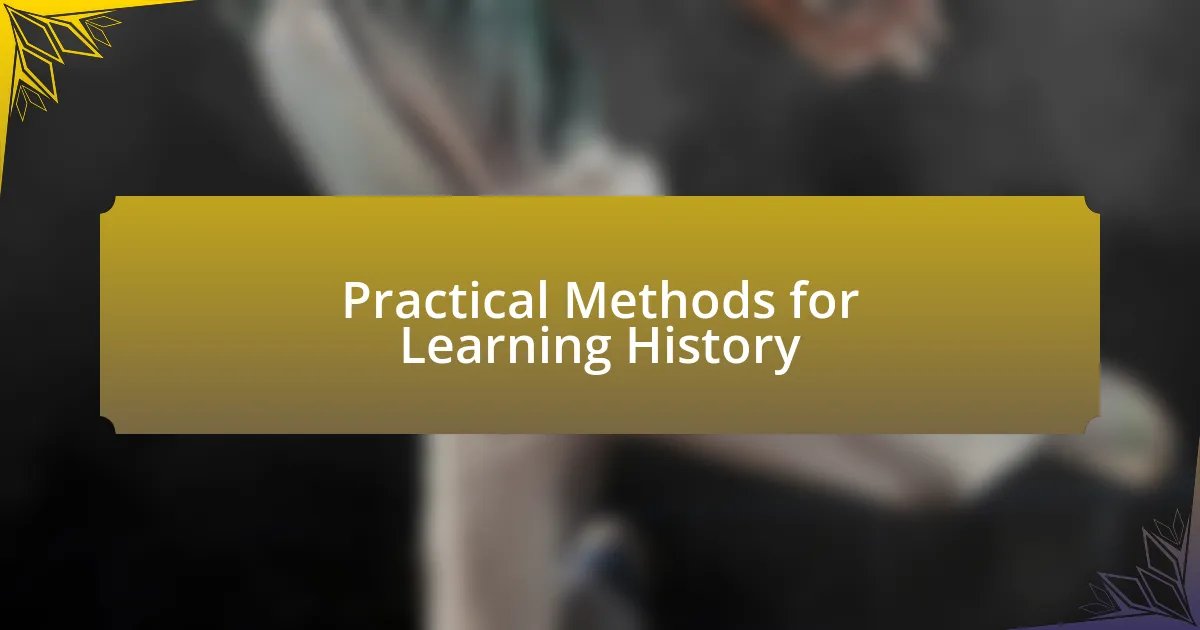
Practical Methods for Learning History
When I talk about practical methods for learning history, one of my favorites is immersing myself in historical fiction. I vividly recall reading a novel set in the Roman Empire that not only entertained me but also sparked my curiosity about everyday life during that era. Have you ever found yourself so captivated by a story that you wanted to learn more about the real events behind it? That’s the magic of blending fact with creativity.
Another effective approach I’ve discovered is participating in local history reenactments or events. Last summer, I joined a reenactment of a medieval festival, and experiencing the sights, sounds, and outfits of that time was nothing short of exhilarating. It made me realize that history isn’t merely something confined to books; it’s alive and can be felt in our interactions and environments. How often do we get to step into the shoes of those who came before us?
Finally, I can’t emphasize enough the benefits of engaging with history through multimedia resources. Podcasts dedicated to ancient civilizations have become a staple in my routine. A recent episode about the fall of the Aztec Empire opened my eyes to the intricacies of their society and its dramatic downfall. Listening to experts discuss these topics can feel like having a conversation with historians, making complex ideas more digestible. Have you ever tried learning history while going for a walk or doing chores? It transforms mundane moments into learning experiences, and it works surprisingly well!
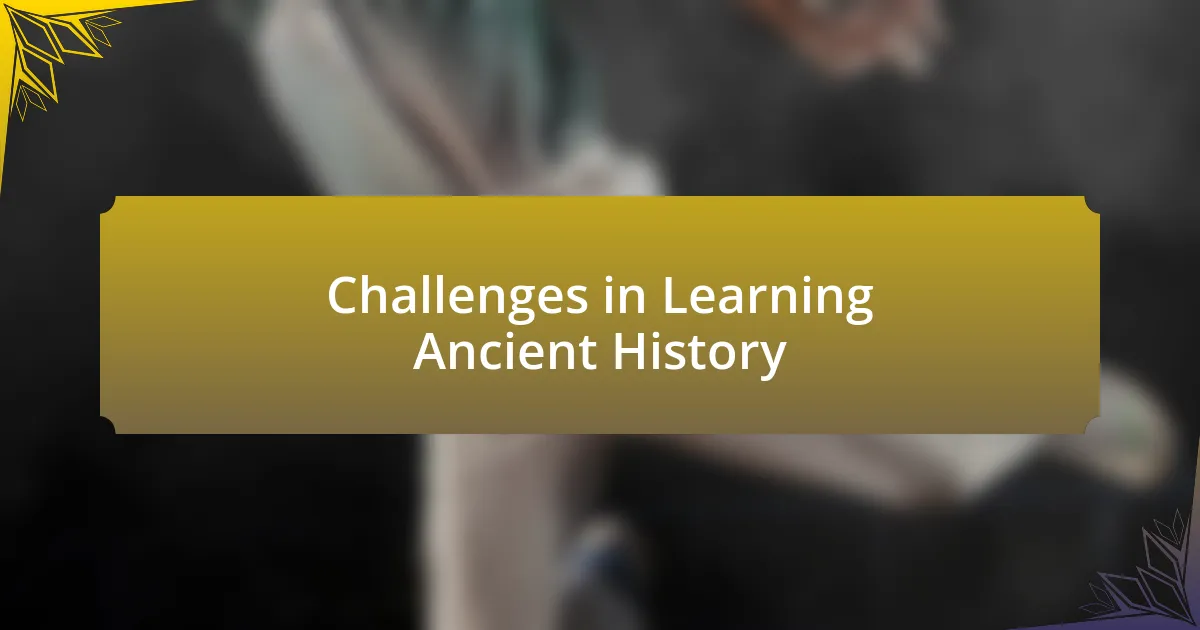
Challenges in Learning Ancient History
Understanding ancient history can often feel like navigating a labyrinth. One significant challenge I’ve faced is the sheer volume of information available. I remember diving into a myriad of texts about the Egyptians, Greeks, and Romans but feeling overwhelmed by dates, names, and events. Have you ever found yourself lost in a sea of facts, unsure of how to piece them together into a cohesive narrative? It’s a daunting experience that can stifle the excitement of learning.
Another hurdle in my journey has been the differing perspectives presented by historians. I once read two books about the same event, yet their interpretations were worlds apart. This discrepancy left me questioning what was factual versus what was biased. How do we truly know which version of history to trust? It’s a challenge that can complicate our understanding and appreciation for the complexities of ancient societies.
Additionally, language barriers can pose unique difficulties. I remember struggling to comprehend ancient texts or translations that felt sterile or unrelatable. When you’re trying to connect emotionally with these historical figures, it can be frustrating to encounter a rigid translation. Does this resonate with you? Finding accessible and engaging material is crucial for making ancient history come alive, and I’ve learned to seek out resources that not only inform but also inspire.
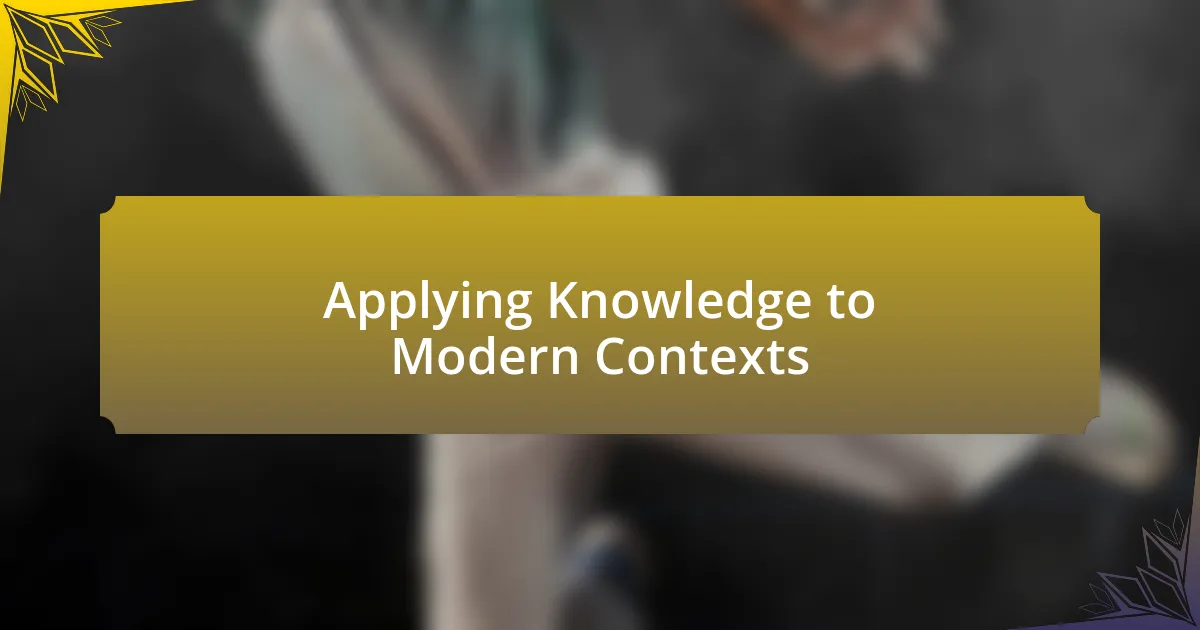
Applying Knowledge to Modern Contexts
Understanding ancient civilizations isn’t just about absorbing facts; it’s about seeing how those lessons resonate today. I often find myself reflecting on the democratic practices of ancient Greece. Their emphasis on civic participation feels more relevant now than ever, especially as we witness global movements advocating for political transparency. Have you thought about how the birth of democracy influences our current systems? It’s fascinating to connect those ancient ideals with modern struggles for freedom and rights.
Additionally, the architectural marvels of civilizations like the Romans inspire me. Hiking through ruins in Italy, I was struck by how their engineering feats laid the groundwork for our cities today. Every arch and aqueduct seemed to whisper tales of innovation and persistence. Isn’t it incredible how those ancient designs still shape our urban landscapes? This realization has pushed me to appreciate contemporary architecture through the lens of history.
On a more personal level, I’ve found that studying ancient cultures influences my worldview. For instance, the values of community and trade that defined ancient societies remind me of the importance of collaboration in our increasingly individualistic society. How can we apply those age-old principles to foster better relationships today? It’s a powerful reminder that, while times have changed, the essence of human connection remains constant.
